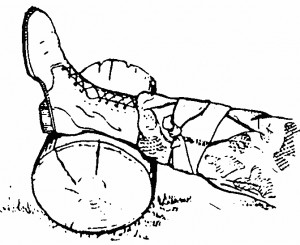a. Check for a Fracture.
Examine the injured limb for fractures (visible broken bone, deformity of the limb, and such).
If a fracture is suspected, do not elevate the wound at this time. If a fractured limb is moved before a splint is applied, the sharp edges of the fractured bone may damage nearby nerves and blood vessels. A fractured limb can be elevated after a splint has been applied to the fractured limb.
b. Elevate the Limb.
If the injured limb is not fractured (or if a splint has already been applied) and the limb does not have an impaled (protruding) object, raise the limb above the level of the casualty’s heart. Elevating the limb will help to decrease blood flow to the injured area and, thereby, reduce bleeding and swelling.
Make sure the limb is supported and the limb will not slip off the support. Elevating the injured limb and applying manual pressure should be done at the same time when no fracture is involved.
(1) If the wound is on a leg, place a pack, log, rock, or other object under the foot and ankle of the injured leg (figure 2-9).
(2) If the wound is on an arm and the casualty is lying on his back, place the casualty’s forearm on his chest.
(3) If wound is on an arm and the casualty is sitting up, have the casualty place his forearm on top of his head.

